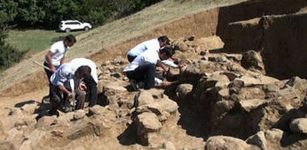The Cyclades And Their Mysterious Society Lost In Time
A. Sutherland - AncientPages.com - Prehistoric Cycladic figurines carved in marble are very ancient artifacts that appeared in the Cycladic society, many centuries before the arising of the famous Minoan Civilization.
Harp player, an example of Cycladic art, at the National Archeological Museum, Athens. Image credit: Robur.q - CC BY-SA 3.0
These earliest settlers probably cultivated barley and wheat and most likely fished the Aegean for tunny and other fish. They had also accomplished sculptors in stone, as attested by significant finds of marble figurines.
What was their real meaning and purpose in the Cycladic society? How important were their enigmatic flat figurines?
A number of them survived looting and vandalism of modern times but for example, on the island Keros, they were intentionally destroyed already during ancient times.
Had this kind of action anything to do with the religious beliefs of those who discovered them on Keros Island? As far as we know, the Cycladic people did not worship the Gods of Olympus that appeared first in the 2nd millennium BC.
Was Keros a major religious center of the enigmatic Cycladic civilization some 4,500 years ago?
As we see, questions are many but answers to them are still missing.
The Cycladic Culture refers to the ancestral Greek culture of the Cycladic islands of the southern Aegean Sea, including the Neolithic (5200-3200 BC) and Early Bronze (3200-2100 BC) ages. The Cycladic culture includes the Minoan civilization.
A very advanced civilization flourished there between 3200 BC - 2000 BC and many crucial discoveries have been made on these ancient islands.
Plenty of curious artifacts - inspired by this unknown civilization - have been found on the islands but certainly, one of the most distinguishing creations of this civilization was the so-called Cycladic figurines. Their enigmatic forms possess great aesthetic power in their very simplicity.
The majority of the figures depict women.
Scientists are now researching a number of important questions regarding the unknown past of the Cycladic Islands. Among them, there is one, particularly important: why did the Cycladic Culture produce history’s largest collection of Cycladic flat-faced marble figurines?
The Cyclades is a group of approximately 220 islands located south-east of the mainland of Greece, with famous names as Santorini (Thira), Tinos, Naxos, Paros, Milos, Mykonos, Ios, and Andros.
The name “Cyclades” refers to the islands forming a circle (the name in English means: “circular islands”). These islands surround the sacred island of Delos. In Greek mythology, the god of the sea, Poseidon, was furious at the Cyclades nymphs and turned them into islands.
The name 'Cyclades' is related to Herodotus, Thucydides, and several other ancient authors.
Akrotiri ruins - first settlement 5,000 years before Christ. A center of Cycladic culture.
According to Strabo (ca. 64 B.C.-ca. A.D. 23), a Greek geographer and historian, the Cyclades formed a circle around the sacred island of Delos. We should remember, however, that the earliest recorded use of the term Cyclades dates to the 5th c. BC. Whether the 3rd millennium BC inhabitants of the Cyclades used the same or similar names for their islands is unknown.
The famous greek archeologist, Christos Tsountas (1857–1934) started his research of the mysterious Cycladic civilization in 1898 and 1899 and investigated burial sites on several islands of the Cyclades.
The Cycladic figurines made of marble originated from the best quarries in Naxos and Paros but for some millennia they have remained anonymous. It is still very little known about the mysterious Cycladic masters who created them.
Archaeologists have difficulties tracing the origins of pre-Greek civilization due to numerous and complex layers of ruins.
The Cyclades, a group of islands in the southwestern Aegean, comprises some thirty small islands and numerous islets. The ancient Greeks called them kyklades, imagining them as a circle (kyklos) around the sacred island of Delos, the site of the holiest sanctuary to Apollo.
Many of these islands are particularly rich in mineral resources—iron ores, copper, lead ores, gold, silver, emery, obsidian, and marble, the marble of Paros and Naxos among the finest in the world.
Archaeological evidence points to sporadic Neolithic settlements on Antiparos, Melos, Mykonos, Naxos, and other Cycladic Islands at least as early as the sixth millennium B.C.
In the third millennium B.C., a distinctive civilization, commonly called the Early Cycladic culture (ca. 3200–2300 B.C.), emerged with important settlement sites on Keros and at Halandriani on Syros. At this time in the Early Bronze Age, metallurgy developed at a fast pace in the Mediterranean. It was especially fortuitous for the Early Cycladic culture that their islands were rich in iron ores and copper, and that they offered a favorable route across the Aegean.
Inhabitants turned to fishing, shipbuilding, and exporting of their mineral resources, as trade flourished between the Cyclades, Minoan Crete, Helladic Greece, and the coast of Asia Minor.
The mystery of the Cycladic Culture is still unsolved.
The first version of this article was originally published on April 12, 2014
Written by – A. Sutherland AncientPages.com Staff Writer
Copyright © AncientPages.com All rights reserved. This material may not be published, broadcast, rewritten or redistributed in whole or part without the express written permission of AncientPages.com
More From Ancient Pages
-
 Ancestral Home Of All Humans Revealed Through World’s Largest Genome Reconstruction Of Our Ancestors
Archaeology | Jan 3, 2023
Ancestral Home Of All Humans Revealed Through World’s Largest Genome Reconstruction Of Our Ancestors
Archaeology | Jan 3, 2023 -
 Ancient Mystery From The Age Of Taurus And The Murdered Astronomer – Evidence In The Arctic ? – Part 2
Featured Stories | Nov 1, 2019
Ancient Mystery From The Age Of Taurus And The Murdered Astronomer – Evidence In The Arctic ? – Part 2
Featured Stories | Nov 1, 2019 -
 The Assyrian Siege Ramp And Breached Walls At Canaanite City Of Lachish – Studied
Archaeology | Nov 10, 2021
The Assyrian Siege Ramp And Breached Walls At Canaanite City Of Lachish – Studied
Archaeology | Nov 10, 2021 -
 Neanderthal Intelligence Revealed By Their Use Of Fire For Cooking
Archaeology | Oct 13, 2023
Neanderthal Intelligence Revealed By Their Use Of Fire For Cooking
Archaeology | Oct 13, 2023 -
 Challenging Prehistoric Gender Roles – Women Were Hunters Too – Not Just Men
Archaeology | Oct 21, 2023
Challenging Prehistoric Gender Roles – Women Were Hunters Too – Not Just Men
Archaeology | Oct 21, 2023 -
 Puzzling Ancient Artifacts Of Unknown Origin And Purpose
Artifacts | Mar 10, 2014
Puzzling Ancient Artifacts Of Unknown Origin And Purpose
Artifacts | Mar 10, 2014 -
 Why Was Celebration Of Christmas, Easter, Midsummer And Saint’s Day Forbidden In Scotland?
Ancient History Facts | Dec 5, 2024
Why Was Celebration Of Christmas, Easter, Midsummer And Saint’s Day Forbidden In Scotland?
Ancient History Facts | Dec 5, 2024 -
 Composition Of A 2,000-Year-Old Roman Perfume Identified For The First Time
Archaeology | May 26, 2023
Composition Of A 2,000-Year-Old Roman Perfume Identified For The First Time
Archaeology | May 26, 2023 -
 Ancient City Machu Picchu Was Originally Called Huayna Picchu By The Incas – Study Of The Name Reveals
Archaeology | Mar 23, 2022
Ancient City Machu Picchu Was Originally Called Huayna Picchu By The Incas – Study Of The Name Reveals
Archaeology | Mar 23, 2022 -
 Is The Legendary Tsuchinoko Real?
Featured Stories | Aug 21, 2019
Is The Legendary Tsuchinoko Real?
Featured Stories | Aug 21, 2019 -
 Researchers Reconstruct Genome Of Centuries-Old E. Coli Using Fragments Extracted From An Italian Mummy
News | Jun 18, 2022
Researchers Reconstruct Genome Of Centuries-Old E. Coli Using Fragments Extracted From An Italian Mummy
News | Jun 18, 2022 -
 The Untold Story Of The Great Sphinx – One Of The Greatest – Part 1
Featured Stories | Aug 9, 2019
The Untold Story Of The Great Sphinx – One Of The Greatest – Part 1
Featured Stories | Aug 9, 2019 -
 Mesha Stele: One Of The Most Valuable Biblical Artifacts
Artifacts | Dec 4, 2020
Mesha Stele: One Of The Most Valuable Biblical Artifacts
Artifacts | Dec 4, 2020 -
 Mythical Danaides: Daughters Of Danaus Condemned In Hades To Eternal Punishment
Featured Stories | Mar 22, 2016
Mythical Danaides: Daughters Of Danaus Condemned In Hades To Eternal Punishment
Featured Stories | Mar 22, 2016 -
 On This Day In History: Battle Of Visby, Gotland Was Fought – On July 27, 1361
News | Jul 27, 2016
On This Day In History: Battle Of Visby, Gotland Was Fought – On July 27, 1361
News | Jul 27, 2016 -
 New Findings In Ancient Palidli Necropolis, Agdam Azerbaijan
Civilizations | Sep 24, 2015
New Findings In Ancient Palidli Necropolis, Agdam Azerbaijan
Civilizations | Sep 24, 2015 -
 Clurichaun – Little Naughty And Drunken Fellow Akin To Leprechaun In Irish Folklore
Featured Stories | Sep 13, 2019
Clurichaun – Little Naughty And Drunken Fellow Akin To Leprechaun In Irish Folklore
Featured Stories | Sep 13, 2019 -
 Legacy Of The Iconic Sycamore Gap Tree – Historical Landmark At Hadrian’s Wall
Featured Stories | Mar 28, 2024
Legacy Of The Iconic Sycamore Gap Tree – Historical Landmark At Hadrian’s Wall
Featured Stories | Mar 28, 2024 -
 Mystery Of The Ancient Sitovo Inscription: Undeciphered Script Or Just A Natural Rock Formation?
Featured Stories | Apr 17, 2016
Mystery Of The Ancient Sitovo Inscription: Undeciphered Script Or Just A Natural Rock Formation?
Featured Stories | Apr 17, 2016 -
 Unique Female Viking Grave In Swedish Mountains Reveals Its Secrets
Archaeology | Jul 14, 2023
Unique Female Viking Grave In Swedish Mountains Reveals Its Secrets
Archaeology | Jul 14, 2023



